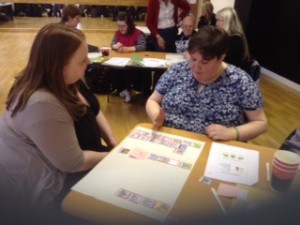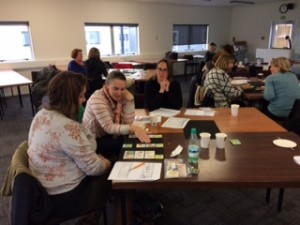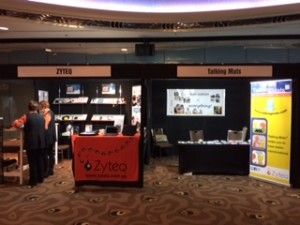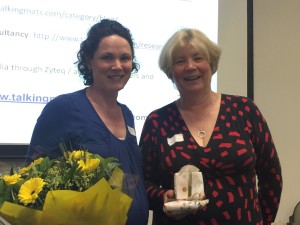Laura Holmes was pleased to meet up with Rachel Clemow, Head Teacher and Donna Wood, Education Support Worker who work for the Virtual Schools Team in Wigan to find out about the impact of Talking Mats training.
Donna accessed a Talking Mats Training last year delivered by a Talking Mats accredited Trainer in Wigan Educational Psychology service and quickly put her training into practice with the children that she works with, using the Consulting Children and Young People – Primary resource pack. Other members of the team soon recognised the potential benefits of introducing this approach themselves, and so, in April 2017, a further 15 members of the Virtual Schools Team received Talking Mats training.
Looked After Children can often struggle to express their thoughts and feelings, often as a result of their situation/ circumstances. This can be further compounded if they also present with speech, language and communication difficulties. There is a higher risk of such difficulties within the LAC population (Cross 1999 ).
Often there are many professionals involved with a Looked After Child, all asking a wide variety of questions, some of which can be highly personal and/or emotive in nature. The team have observed that children will sometimes end up giving answers which they think the listener wants to hear, rather than answers which reflect their true feelings/views – or the child may withdraw from the process entirely. Consequently, it can be very difficult to ensure that the true ‘voice of the child’ is being heard. Sometimes the children themselves struggle to understand what their own feelings are – often the topics and questions can be complex and involve abstract concepts.
Rachel and Donna report that the Talking Mats approach has had a big impact on their communication style when working with the children on their caseloads, and has enabled children to express their thoughts and views in a safe, neutral environment. Some of the comments they made about Talking Mats were that it:
– Enables the listener to get to know a child quicker and more easily as there is no pressure/expectation of the ‘thinker’ – it is a child/’thinker’ led approach.
– Provides way of supporting the child to open up to express their views and feelings, even if they have previously been hard to engage – and for the child to develop better insight into their own feelings.
– Helps to avoid the possibility of adult/listener misinterpretation of what the child is trying to communicate.
– Enables the child to focus on pictures – which appears to result in the child being more comfortable in expressing their own views and feelings – as opposed to what the child thinks the listener wants to hear.
– Provides a holistic view of the child – which can support target setting and planning at key stages for that child, for example, transition to High School.
– Gives the child something they can be successful at – there are no ‘wrong’ answers.
Donna shared a great example of how Talking Mats helped a young girl to describe an issue at home which she had not shared with any carers or school staff previously. The child placed the ‘home’ option symbol on the ‘not happy’ section of the mat then began to whisper to Donna explaining the reason why. This resulted in Donna being able to share the information with school staff and social care, consequently, the issue was resolved.
Services, organisations and schools in Wigan are already using the Talking Mats approach as a result of widespread training delivered by our Accredited trainers in the Educational Psychology Team. This provides a great example of how using Talking Mats across agencies can really help a whole area to become more child/ young person led.
The Virtual Schools team are now recommending the Talking Mats approach to other agencies working with the Looked After Children on their caseloads, such as adoption and fostering services.
If want to access the training then there are Talking Mats foundation courses run regularly in London, Stirling , Manchester and Newcastle . Once you have attended a foundation training and gained experience you can apply to become an accredited trainer .
This is the second blog about Lois and Nicki’s amazing visit to Australasia – this time theirTalking Mats trip to New Zealand.
The view flying into New Zealand was dramatic. We looked down on a beautiful range of snow topped mountains glistening in the clear blue sky as our plane flew towards Christchurch. Our first stop was the South island for a foundation training organised by Talk Link. Our second foundation training was in Auckland in the North Island. At both places we had a fantastic group of interested practitioners who really engaged with how Talking Mats could be used and began thinking creatively about how they would apply in their work place .This included:
• Involving thinkers in decisions about the their alternative and augmentative communication and getting feedback on what works for them
• Exploring its value for young people in the youth justice system to support them to express their views and be a tool for increasing engagement
• Exploring how Talking Mats could be adapted to make them more accessible and culturally accepted to the Maori community
• Involving children in their education planning
We were really pleased that Talk Link also sent 3 staff to the accredited training course in Australia. This means that there will be increased access to Talking Mats Foundation training in New Zealand for the future. Our experience is that accredited trainers provide leadership that helps organisations embed Talking Mats into practice. Thanks to Ann Smaill for all her organising and support for both our Foundation and Accredited courses.
And our leisure times were special too. We had a trip on the Christchurch Gondola to see the stunning Banks peninsula; we experienced the hope and resilience of Christchurch following the earthquakes in 2010 and 2011. In Auckland we saw a thought provoking Maori exhibition and last but not least we loved our weekend of rest and relaxation on the very special island of Waiheke. The locals thought us mad to swim in the sea their autumn but we loved it!
More information
Click for more information if you want to find out about
It was a great privilege for Nicki and Lois to visit to Australia and New Zealand and share our experience of Talking Mats with such a fantastic group of interested people. We learned a lot about the opportunities and challenges their work settings present. Our first blog focuses on Australia and the second on New Zealand.
Australia
Agosci
We had just over two weeks in Australia. During that time we attended and presented at the Agosci conference – a great gathering of practitioners from all over Australia and further afield who are focused in improving practice in Alternative and Augmentative communication. There was a lot of interest in Talking Mats – our stall was busy and our preconference workshop full.
A key driver for the interest was the implementation of the National Disability Insurance Scheme (NDIS) which is changing the way the individual packages of care are being administered with the need to establish what is important to the person and their life goals. Talking Mats is recognised as a great tool to help that happen and although there did not appear to be any NDIS planners at the conference we are hopeful with the buzz that was created the message will get out.
Dementia
It was interesting for us to see that at Agosci there was no mention of the role augmentative and alternative communication could play in terms of supporting communication with people with dementia. It is true that in the UK equivalent conference ‘Communication Matters’, the use of AAC in dementia is not the strongest theme but you will still find discussion and papers about it. It felt to us the world of AAC and dementia was still very separate in Australia and closing that gap could provide an enhanced quality of life for people with dementia.
We appreciated being invited to deliver training for Hammond Care in Sydney. They were an experienced group of practitioners and we had interesting discussions about using Talking Mats in their work with people with dementia.
We are excited too that one of our new Australian accredited trainer, Lyn Philipson will be using Talking Mats in her research with people with dementia.
Keeping Safe
Our new ‘Keeping Safe’ resource sparked a great deal of interest. Naomi Rezzani of Scope Australia organised a seminar which Lois was invited to speak at.
It was good to hear about the local initiatives in the state of Victoria to support people with learning disabilities who have experienced or are at risk of abuse . The presentations discussed the role of advocacy, therapeutic support, education about rights, the Scope ‘Speaking Out’ resources that support communication. The countries may be different but themes are similar.
Accredited training and Zytec
At the end of our stay we held an accredited training course and are delighted that 9 Australians and and 3 New Zealanders can now provide training in their respective organisations.
Throughout our visit we were very well supported by our Australian Partner Zyteq and being able to work closely with them for two weeks has strengthened our partnership. We are delighted that Tracey Bode and Karyn Muscat of Zyteq will continue promoting Talking Mats in Australia. They are the Australian providers of face to face training and the original Talking Mats resources
Time off!
It was of course not all work. We loved seeing for real the iconic images of Sydney opera house the harbour bridge , bronzed bodies surfing in the sea , Melbourne with its myriad of art deco buildings , graffiti street art and the cute wee St Kilda fairy penguins. So lots of happy memoires and hopes we will be back.
More information
Click for more information if you want to find out about

Talking Mats and the National Involvement Network (NIN) have been working together for the past year to enable the NIN members to develop a Talking Mat and to use that Mat to listen to the experiences of people with learning disabilities . It has been a great project and we wrote up the experience of running the training in two earlier blogs.
The first blog described how we worked with the group to develop a Talking Mat to link with the NIN’s charter for involvement . The second how we developed and delivered a Talking Mats training course to meet the needs of the NIN members all of whom have learning disabilities
The group then set off to carry out their Talking Mats conversations supported by staff from their respective organisations and or ARC Scotland. The group decided they wanted to make a film about their experiences of using Talking Mats and ARC Scotland supported them to do this . Rhona and I were delighted when we got this link to the film all about their experiences of using Talking Mats. We really enjoyed watching it and we are sure you will to. https://www.youtube.com/watch?v=0BTlYuqLBXs
Five short stories from our recent accredited training course in Stirling.
- A looked after child was unhappy but no one knew specifically why. Using the Talking Mats, she indicated that she was upset by the weekly phone call with her mother because it always happened when it was her playing time. The time of the call was moved to just before her bedtime but this resulted in bad dreams. The time of the call was finally moved to Saturday afternoon which helped her settle and reduced her distress.
- Talking Mats was used with an Iraqi boy who had come to England via Libya, Italy and the jungle camp at Calais. When he picked the symbol of a waiting room he indicated that despite all she had been through he really liked this because it reminded him of all the children in his family and made him happy.
- A 76-year-old man with a learning disability disclosed that he had been attacked and suffocated by his upstairs neighbour one week previously. It was only when he used the Talking Mats that he disclosed to anyone what had happened.
- A lecturer usually used quantifying measuring with her students to find out how they were managing their studies. Instead she used Talking Mats to find out how they were coping with their work life balance. One student told her that she was managing fine except that her pet rabbits always escape under the bed and it takes her a long time to get them back out so she does not let them out very often!
- Talking Mats was used with a man who had had a stroke and had to go into residential care because his family could no longer look after him. They were very worried that he was unhappy with the new care set up. He was able to show with the Talking Mats that he was happy about everything except that he was not given enough time when he went to the toilet. Once the staff realised this they then gave him more time which resolved the situation and reassured his family.
Please send us your Talking Mats stories – we love hearing them.
 Online training login
Online training login 






